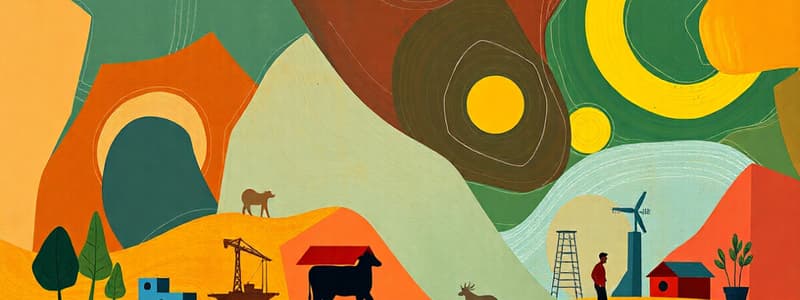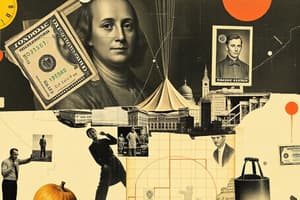Podcast
Questions and Answers
In a command economy, who is responsible for making the major economic decisions?
In a command economy, who is responsible for making the major economic decisions?
What does the Production Possibility Frontier (PPF) illustrate?
What does the Production Possibility Frontier (PPF) illustrate?
Which economic system describes a situation where both government and private firms influence economic decisions?
Which economic system describes a situation where both government and private firms influence economic decisions?
In a market economy, what primarily determines the price and quantity of goods and services?
In a market economy, what primarily determines the price and quantity of goods and services?
Signup and view all the answers
Which statement regarding firms in a market economy is correct?
Which statement regarding firms in a market economy is correct?
Signup and view all the answers
What happens to total revenue when the demand is price-elastic and the price decreases?
What happens to total revenue when the demand is price-elastic and the price decreases?
Signup and view all the answers
What characteristic best defines inelastic demand?
What characteristic best defines inelastic demand?
Signup and view all the answers
If the price elasticity at a certain point is measured as 3, what can be inferred about the demand at that point?
If the price elasticity at a certain point is measured as 3, what can be inferred about the demand at that point?
Signup and view all the answers
What results from a leftward shift in the supply curve?
What results from a leftward shift in the supply curve?
Signup and view all the answers
For products considered inelastic, like agriculture or food, what happens when prices increase?
For products considered inelastic, like agriculture or food, what happens when prices increase?
Signup and view all the answers
What does efficiency denote in the context of economics?
What does efficiency denote in the context of economics?
Signup and view all the answers
Which concept refers to the application of statistical tools to analyze data relationships?
Which concept refers to the application of statistical tools to analyze data relationships?
Signup and view all the answers
What differentiates microeconomics from macroeconomics?
What differentiates microeconomics from macroeconomics?
Signup and view all the answers
What does 'caeteris paribus' imply in economic analysis?
What does 'caeteris paribus' imply in economic analysis?
Signup and view all the answers
In the context of income distribution, which statement is correct based on the details provided?
In the context of income distribution, which statement is correct based on the details provided?
Signup and view all the answers
What does a point inside the production possibilities frontier (PPF) indicate?
What does a point inside the production possibilities frontier (PPF) indicate?
Signup and view all the answers
Which of the following best describes the trade-off a nation faces when prioritizing investments in public goods?
Which of the following best describes the trade-off a nation faces when prioritizing investments in public goods?
Signup and view all the answers
Which statement accurately describes points outside the production possibilities frontier (PPF)?
Which statement accurately describes points outside the production possibilities frontier (PPF)?
Signup and view all the answers
What is a consequence of high unemployment during severe business cycles?
What is a consequence of high unemployment during severe business cycles?
Signup and view all the answers
When a country is in severe poverty, which should it prioritize according to the provided content?
When a country is in severe poverty, which should it prioritize according to the provided content?
Signup and view all the answers
Study Notes
Economics Chapter Summaries
- Economics is the study of how societies allocate scarce resources to produce valuable goods and services, and distribute them among individuals.
- Societies face choices about how to use scarce resources because of scarcity, which is the idea that goods are limited relative to desires.
- Efficiency denotes the most effective use of limited resources to satisfy needs and wants.
- An economy should produce the highest quantity and quality of goods possible given its resources and technology.
- Resources include land, labor, and capital.
- Production involves creating goods (tangible) and services (intangible).
- Consumption involves using goods and services to fulfill current and future needs.
- The concept of distribution addresses how resources are shared among individuals.
- A nation's income inequality is measured by the proportion of national income contributed by the top 1% versus the bottom 50%.
- Economic systems, such as command, mixed, and market economies, are different ways of solving the economic problems of allocation, production, and distribution.
- In a command economy, the government controls all major economic decisions.
- In a mixed economy, both the government and private individuals play a role in the economy.
- In a market economy, individuals and firms make the most of production and distribution decisions.
- A “market mechanism” describes interaction between supply and demand to determine prices and exchanges of goods and services. At equilibrium, prices balance supply and demand.
- Trade and specialization benefit individuals and countries by increasing expertise and the range of goods and services that are available.
- Globalization results from increased trade among countries.
- Societies must decide whether to prioritize current consumption or investment, for example, prioritizing either private goods or public goods.
- Governments can correct issues of market failure by providing public goods, ensuring competition, and preventing externalities.
- Market failure arises when markets do not function optimally.
- Examples of market failures include imperfectly competitive markets or monopolies, externalities, and public goods.
- Markets that are perfectly competitive have many firms, homogeneous products, and no barriers to entry.
- Demand curves represent the amount of a good or service that consumers are willing to purchase at various prices.
- Supply curves represent the amount of a good or service that producers are willing to supply at various prices.
- Changes in market prices or other factors cause shifts in supply and demand curves.
- Market clearing occurs when quantity demanded equals quantity supplied, establishing equilibrium price.
- Price elasticity is the measure of how responsive demand or supply is to a change in price.
- Inelastic demand occurs when a change in price has a small impact on quantity demanded.
- Elastic demand occurs when a change in price has a large impact on quantity demanded.
- Consumers primarily bear the burden of taxes on inelastically demanded goods.
- Producers primarily bear the burden of taxes on inelastically supplied goods.
- Different economic ideas can be used to understand how societies make choices and whether certain economic ideas work better in certain situations.
Economical Concepts
- Scarcity
- Efficiency
- Resources
- Production
- Consumption
- Distribution
- Command Economy
- Mixed Economy
- Market Economy
- Market mechanism
- Trade
- Globalization
- Market Failure
- Perfect competition
- Price elasticity
- Demand
- Supply
- Equilibrium
- Taxes
Studying That Suits You
Use AI to generate personalized quizzes and flashcards to suit your learning preferences.
Related Documents
Description
Explore the key concepts of economics through these chapter summaries. This quiz covers the allocation of scarce resources, the importance of efficiency, and the dynamics of production, consumption, and distribution. Gain insights into how different economic systems operate and their impact on income inequality.




